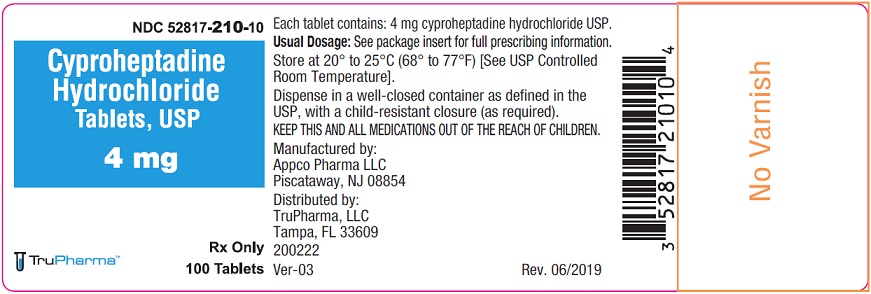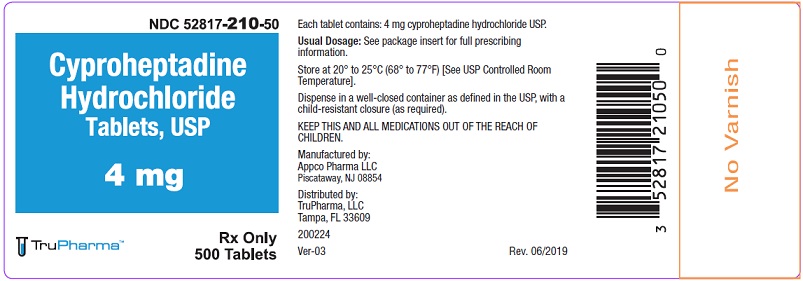Label: CYPROHEPTADINE HYDROCHLORIDE tablet
- NDC Code(s): 52817-210-10, 52817-210-50
- Packager: TRUPHARMA, LLC
- Category: HUMAN PRESCRIPTION DRUG LABEL
- DEA Schedule: None
- Marketing Status: Abbreviated New Drug Application
Drug Label Information
Updated March 25, 2022
If you are a consumer or patient please visit this version.
- Download DRUG LABEL INFO: PDF XML
- Official Label (Printer Friendly)
-
DESCRIPTION
Cyproheptadine HCl USP, is an antihistaminic and antiserotonergic agent. Cyproheptadine hydrochloride USP is a white to slightly yellowish crystalline powder, with a molecular weight of 350.89, which is slightly soluble in water, freely soluble in methanol, sparingly soluble in alcohol, soluble in chloroform, and practically insoluble in ether. It is the sesquihydrate of 4-(5H dibenzo[a,d]cyclohepten-5-ylidene)-1-methylpiperidine hydrochloride. The molecular formula of the anhydrous salt is C21H21N•HCl and the structural formula of the anhydrous salt is:

Cyproheptadine hydrochloride USP is available for oral administration in 4 mg tablets. Inactive ingredients include: lactose monohydrate, magnesium stearate, microcrystalline cellulose, and sodium starch glycolate.
- CLINICAL PHARMACOLOGY
-
Pharmacokinetics and Metabolism
After a single 4 mg oral dose of 14C-labelled cyproheptadine HCI in normal subjects, given as tablets, 2 to 20% of the radioactivity was excreted in the stools. Only about 34% of the stool radioactivity was unchanged drug, corresponding to less than 5.7% of the dose. At least 40% of the administered radioactivity was excreted in the urine. No detectable amounts of unchanged drug were present in the urine of patients on chronic 12 to 20 mg daily doses. The principle metabolite found in human urine has been identified as a quaternary ammonium glucuronide conjugate of cyproheptadine. Elimination is diminished in renal insufficiency.
-
INDICATIONS AND USAGE
Perennial and seasonal allergic rhinitis
Vasomotor rhinitis
Allergic conjunctivitis due to inhalant allergens and foods
Mild, uncomplicated allergic skin manifestations of urticaria and angioedema.
Amelioration of allergic reactions to blood or plasma
Cold urticaria
Dermatographism
As therapy for anaphylactic reactions adjunctive to epinephrine and other standard measures after the acute manifestations have been controlled.
-
CONTRAINDICATIONS
Newborn or Premature Infants
This drug should not be used in newborn or premature infants.
Nursing Mothers
Because of the higher risk of antihistamines for infants generally and for newborns and prematures in particular, antihistamine therapy is contraindicated in nursing mothers.
Other Conditions
Hypersensitivity to cyproheptadine and other drugs of similar chemical structure.
Monoamine oxidase inhibitor therapy (See DRUG INTERACTIONS.)
Angle-closure glaucoma
Stenosing peptic ulcer
Symptomatic prostatic hypertrophy
Bladder neck obstruction
Pyloroduodenal obstruction
Elderly, debilitated patients
-
WARNINGS
Pediatric Patients
Overdosage of antihistamines, particularly in infants and young children, may produce hallucinations, central nervous system depression, convulsions, respiratory and cardiac arrest, and death.
Antihistamines may diminish mental alertness; conversely, particularly, in the young child, they may occasionally produce excitation.
CNS Depressants
Antihistamines may have additive effects with alcohol and other CNS depressants, e.g., hypnotics, sedatives, tranquilizers, antianxiety agents.
Activities Requiring Mental Alertness
Patients should be warned about engaging in activities requiring mental alertness and motor coordination, such as driving a car or operating machinery. Antihistamines are more likely to cause dizziness, sedation, and hypotension in elderly patients (see PRECAUTIONS, Geriatric Use).
-
PRECAUTIONS
General
Cyproheptadine has an atropine-like action and, therefore, should be used with caution in patients with:
History of bronchial asthma
Increased intraocular pressure
Hyperthyroidism
Cardiovascular disease
Hypertension
Information for patients
Antihistamines may diminish mental alertness; conversely, particularly, in the young child, they may occasionally produce excitation. Patients should be warned about engaging in activities requiring mental alertness and motor coordination, such as driving a car or operating machinery.
Drug interactions
MAO inhibitors prolong and intensify the anticholinergic effects of antihistamines.
Antihistamines may have additive effects with alcohol and other CNS depressants, e.g., hypnotics, sedatives, tranquilizers, antianxiety agents.
Carcinogenesis, mutagenesis, impairment of fertility
Long-term carcinogenic studies have not been done with cyproheptadine. Cyproheptadine had no effect on fertility in a two-litter study in rats or a two generation study in mice at about 10 times the human dose.
Cyproheptadine did not produce chromosome damage in human lymphocytes or fibroblasts in vitro; high doses (10-4M) were cytotoxic. Cyproheptadine did not have any mutagenic effect in the Ames microbial mutagen test; concentrations of above 500 mcg/plate inhibited bacterial growth.
Pregnancy
Pregnancy Category B
Reproduction studies have been performed in rabbits, mice, and rats at oral or subcutaneous doses up to 32 times the maximum recommended human oral dose and have revealed no evidence of impaired fertility or harm to the fetus due to cyproheptadine. Cyproheptadine has been shown to be fetotoxic in rats when given by intraperitoneal injection in doses four times the maximum recommended human oral dose. Two studies in pregnant women, however, have not shown that cyproheptadine increases the risk of abnormalities when administered during the first, second and third trimesters of pregnancy. No teratogenic effects were observed in any of the newborns. Nevertheless, because the studies in humans cannot rule out the possibility of harm, cyproheptadine should be used during pregnancy only if clearly needed.
Nursing mothers
It is not known whether this drug is excreted in human milk. Because many drugs are excreted in human milk, and because of the potential for serious adverse reactions in nursing infants from cyproheptadine, a decision should be made whether to discontinue nursing or to discontinue the drug, taking into account the importance of the drug to the mother (see CONTRAINDICATIONS).
Pediatric use
Safety and effectiveness in pediatric patients below the age of two have not been established (see CONTRAINDICATIONS, Newborn or Premature Infants,and WARNINGS, Pediatric Patients).
Geriatric use
Clinical studies of cyproheptadine HCl tablets did not include sufficient numbers of subjects aged 65 and over to determine whether they respond differently from younger subjects. Other reported clinical experience has not identified differences in responses between the elderly and younger patients. In general, dose selection for an elderly patient should be cautious, usually starting at the low end of the dosing range, reflecting the greater frequency of decreased hepatic, renal, or cardiac function, and of concomitant disease or other drug therapy (see WARNINGS, Activities Requiring Mental Alertness).
-
ADVERSE REACTIONS
Adverse reactions which have been reported with the use of antihistamines are as follows:
Central Nervous System
Sedation and sleepiness (often transient), dizziness, disturbed coordination, confusion, restlessness, excitation, nervousness, tremor, irritability, insomnia, paresthesias, neuritis, convulsions, euphoria, hallucinations, hysteria, faintness.
Integumentary
Allergic manifestation of rash and edema, excessive perspiration, urticaria, photosensitivity.
Digestive System
Cholestasis, hepatic failure, hepatitis, hepatic function abnormality, dryness of mouth, epigastric distress, anorexia, nausea, vomiting, diarrhea, constipation, jaundice.
-
OVERDOSAGE
Antihistamine overdosage reactions may vary from central nervous system depression to stimulation especially in pediatric patients. Also, atropine-like signs and symptoms (dry mouth; fixed, dilated pupils; flushing, etc.) as well as gastrointestinal symptoms may occur.
If vomiting has not occurred spontaneously, the patient should be induced to vomit with syrup of ipecac.
If patient is unable to vomit, perform gastric lavage followed by activated charcoal. Isotonic or 1/2 isotonic saline is the lavage of choice. Precautions against aspiration must be taken especially in infants and children.
When life threatening CNS signs and symptoms are present, intravenous physostigmine salicylate may be considered. Dosage and frequency of administration are dependent on age, clinical response, and recurrence after response. (See package circulars for physostigmine products.)
Saline cathartics, as milk of magnesia, by osmosis draw water into the bowel and, therefore, are valuable for their action in rapid dilution of bowel content. Stimulants should not be used.
Vasopressors may be used to treat hypotension.
The oral LD50 of cyproheptadine is 123 mg/kg, and 295 mg/kg in the mouse and rat, respectively.
-
DOSAGE AND ADMINISTRATION
DOSAGE SHOULD BE INDIVIDUALIZED ACCORDING TO THE NEEDS AND THE RESPONSE OF THE PATIENT.
Each tablet contains 4 mg of cyproheptadine hydrochloride.
Pediatric Patients
Age 2 to 6 years
The total daily dosage for pediatric patients may be calculated on the basis of body weight or body area using approximately 0.25 mg/kg/day or 8 mg per square meter of body surface (8 mg/m2).
The usual dose is 2 mg (1/2 tablet) two or three times a day, adjusted as necessary to the size and response of the patient. The dose is not to exceed 12 mg a day.
Age 7 to 14 years
The usual dose is 4 mg (1 tablet) two or three times a day adjusted as necessary to the size and response of the patient. The dose is not to exceed 16 mg a day.
Adults
The total daily dose for adults should not exceed 0.5 mg/kg/day. The therapeutic range is 4 to 20 mg a day, with the majority of patients requiring 12 to 16 mg a day. An occasional patient may require as much as 32 mg a day for adequate relief. It is suggested that dosage be initiated with 4 mg (1 tablet) three times a day and adjusted according to the size and response of the patient.
-
HOW SUPPLIED
Cyproheptadine Hydrochloride Tablets USP are available as white to off white, round, flat-faced, beveled edged tablets, debossed with “MCR and 109” separated by functional score on one side and plain on the other side, containing 4 mg of cyproheptadine HCI packaged in bottles of 100 (NDC 52817-210-10) and 500 tablets (NDC 52817-210-50).
PHARMACIST: Dispense in a well-closed container as defined in the USP, with a child-resistant closure (as required).
Store at 20° to 25°C (68° to 77°F) [See USP Controlled Room Temperature].
Manufactured by:
Appco Pharma LLC
Piscataway, NJ 08854
Distributed by:
TruPharma, LLC
Tampa, FL 33609
Revised: 02/2022
200223
Ver-04
- PRINCIPAL DISPLAY PANEL
-
INGREDIENTS AND APPEARANCE
CYPROHEPTADINE HYDROCHLORIDE
cyproheptadine hydrochloride tabletProduct Information Product Type HUMAN PRESCRIPTION DRUG Item Code (Source) NDC:52817-210 Route of Administration ORAL Active Ingredient/Active Moiety Ingredient Name Basis of Strength Strength CYPROHEPTADINE HYDROCHLORIDE (UNII: NJ82J0F8QC) (CYPROHEPTADINE - UNII:2YHB6175DO) CYPROHEPTADINE HYDROCHLORIDE 4 mg Inactive Ingredients Ingredient Name Strength CELLULOSE, MICROCRYSTALLINE (UNII: OP1R32D61U) LACTOSE MONOHYDRATE (UNII: EWQ57Q8I5X) MAGNESIUM STEARATE (UNII: 70097M6I30) SODIUM STARCH GLYCOLATE TYPE A POTATO (UNII: 5856J3G2A2) Product Characteristics Color WHITE (White to Off-White) Score no score Shape ROUND Size 7mm Flavor Imprint Code MCR;109 Contains Packaging # Item Code Package Description Marketing Start Date Marketing End Date 1 NDC:52817-210-10 100 in 1 BOTTLE, PLASTIC; Type 0: Not a Combination Product 01/17/2017 2 NDC:52817-210-50 500 in 1 BOTTLE, PLASTIC; Type 0: Not a Combination Product 01/17/2017 Marketing Information Marketing Category Application Number or Monograph Citation Marketing Start Date Marketing End Date ANDA ANDA206553 01/17/2017 Labeler - TRUPHARMA, LLC (078533947) Registrant - Appco Pharma LLC (078510186) Establishment Name Address ID/FEI Business Operations Appco Pharma LLC 078510186 ANALYSIS(52817-210) , MANUFACTURE(52817-210) , PACK(52817-210)




